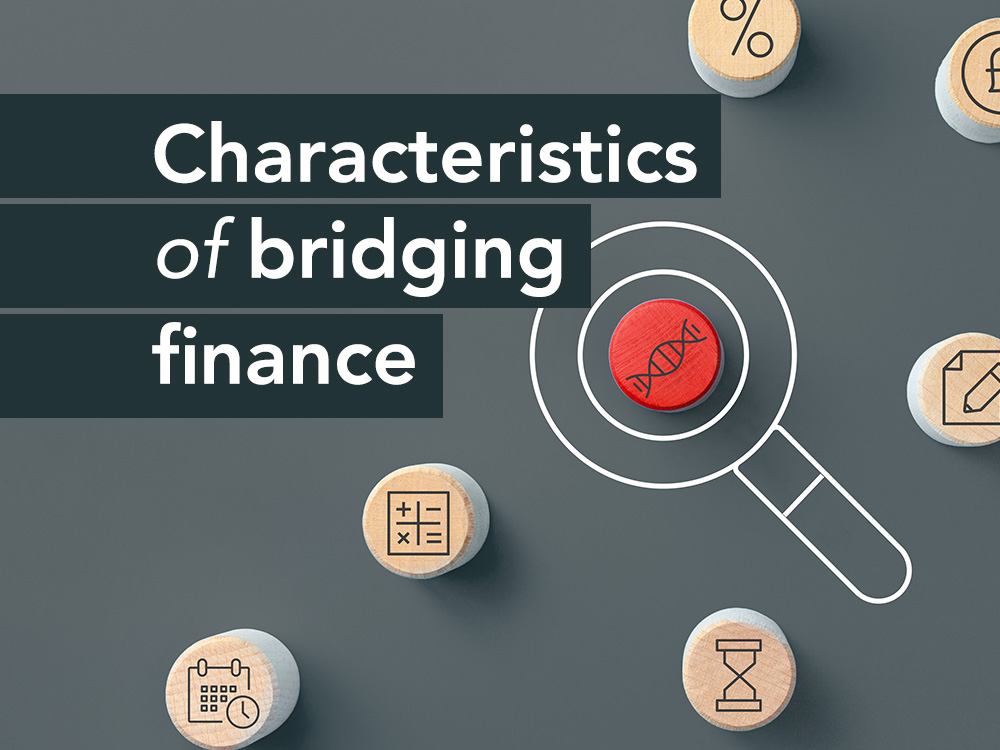Characteristics of bridging finance
While the basic principle of bridging finance is simple – i.e. it’s a short-term loan extended against an asset – there are several variations within the sector. Here are the main considerations to bear in mind.

Regulated or unregulated bridging loans
If you take out a loan against a residential property that you or a close family member lives in, or intends to live in, then it will be a regulated loan, overseen by the Financial Conduct Authority (FCA). This means that the lender will look at how affordable the loan is for you, based on your income streams, to ensure that you can meet repayments.
The FCA regulates this area of bridging finance and has the power to fine companies that break its rules. Borrowers can complain to the FCA if they feel they have been unfairly treated or missold a regulated bridging loan, potentially winning compensation.
The FCA regulates more than 50,000 financial services companies in the UK, protecting consumers and enhancing market integrity. To check whether a company is covered by the FCA, search its register at http://register.fca.org.uk/.
Borrowers still have to be aware that their homes may be at risk if they fail to repay their regulated bridging loan.
Bridging loans for any other kind of property, including buy-to-let residences, commercial property or development land are unregulated, so they do not come under the responsibility of the FCA.
Unregulated bridging loans typically attract a higher interest rate than regulated loans, along with stricter terms, because they pose more of a risk to the lender.
Also, be aware that some lenders don’t offer regulated bridging loans, so check with your lender before applying.
Open or closed bridging loans
An open bridging loan has no fixed end date, it simply means that the loan is repaid whenever money becomes available – usually from the sale of a property. Generally, borrowers take out open loans for up to a year, although they can extend for longer in some cases. These loans suit borrowers who, for example, have found a property to buy, but haven’t yet sold their existing home.
Closed bridging loans have a fixed completion date, set in advance, based on prior knowledge of when funds will become available. These are typically used by borrowers who need money over a very short term, say a few weeks or a couple of months. An example where a closed loan would be suitable is if you’ve exchanged on a property sale and are simply waiting for completion to access funds.
Closed bridging loans generally attract lower interest rates than open loans, since they offer less flexibility.
Due to the fact most closed bridging loans do not come with early repayment fees, the difference between taking out an open bridging loan Vs. a closed bridging loan can be small in reality.
First or second charge bridging loans
If you already have a mortgage on a property, you may still be able to access a bridging loan against its value, as a ‘second charge’ loan. This means that, in the case of default, the original mortgage lender (the ‘first charge’) is first in line to recoup their loan, since it is noted on the Land Registry and the owner cannot sell it without the approval of the lender.
Second charge bridging loans are a useful, quick and flexible way of raising additional finance against a property’s value without the expense, time and administration of arranging a remortgage. Borrowers can access more money than they would typically get through an unsecured loan or credit card.
Second charge bridging loans require more detailed preparation than first charge bridging, since lenders need to see evidence of the borrower’s credit history and financial documentation, so they typically take longer to complete.
The advantage of a second charge bridging loan is that it does not depend on a multiple of a borrower’s income, and the level of loan-to-value (LTV) relating to a property can be higher than for a typical mortgage.
Interest rate options
Similar to a traditional mortgage, borrowers can choose between fixed rate and variable rate bridging loans. Equally, fixed rate deals are likely to be a bit more expensive than variable rate deals, but they guarantee you a repayment sum over the lifetime of the loan.
Individual bridging lenders will set their interest rates according to the perceived risk of the loan, charging a higher rate to borrowers who want a higher loan-to-value deal, for example, or who have a less certain exit strategy or a lower credit rating.
In general, most bridging loan borrowers defer paying interest until the end of their term, when they repay the capital plus ‘rolled up’ or ‘retained’ interest.
‘Retained’ interest is where borrowers keep back from the loan a sum equal to a number of monthly interest payments, which they choose. The ‘retained’ interest remains part of the total amount that they’ve borrowed, but there could be an amount left over, once the loan has been paid back. The lender would then repay this amount.
It’s important to note that when lenders talk about loan-to-value (LTV), the ‘loan’ includes not only the capital amount but some or all of the fees and interest added up together.
The actual interest rate charged may be anything from 0.5 per cent to 2 per cent per month, depending upon individual lenders’ policies, the state of the market, the valuation of the property, the LTV of the loan and the creditworthiness of the borrower.
Fees
An arrangement fee of 2 per cent is commonly charged by bridging finance companies.
Borrowers have to cover the cost of a property survey, which will typically cost between £600 and £800. An approximate rule of thumb is a valuation costs around £100 to £200 for every £100,000 of property value.
They will also have to pay legal fees, adding up to another £1,200 to £1,500.
Further costs include a telegraphic transfer fee of around £25, an administration fee of around £300 and a broker fee which is typically 1 to 2 per cent of the loan.
Some lenders also charge an exit fee at the end of the loan, which may be 1 per cent of the total.
In conclusion
Borrowers should always weigh up the total costs and benefits of bridging finance. It is an expensive way of borrowing money, so they should be sure that the advantages of speed, flexibility and ease of access are really more important than higher interest rates and the threat of losing a property if things go wrong.





